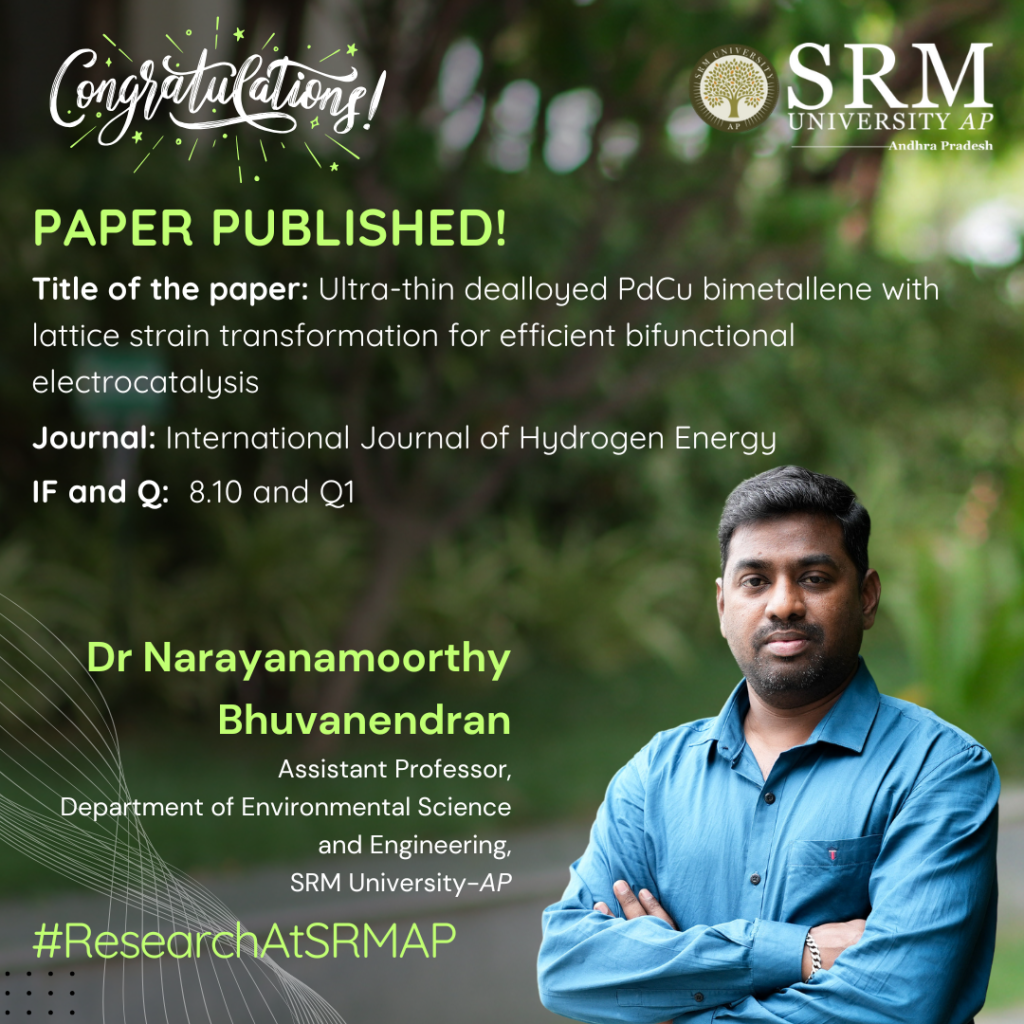
Dr Narayanamoorthy Bhuvanendran, Assistant Professor in the Department of Environmental Science and Engineering, has published his research work as an article titled “Ultra-thin Dealloyed PdCu Bimetallene with Lattice Strain Transformation for Efficient Bifunctional Electrocatalysis” in the esteemed International Journal of Hydrogen Energy, which has an impact factor of 8.10. His work underscores the development of 2D PdCu bimetallene with improved structural and electronic properties displaying super-catalytic behaviour.
Abstract
Two-dimensional (2D) PdCu bimetallene (PdCu) demonstrates exceptional structural and electronic properties, making it highly effective for electrochemical reactions in energy applications. Electrochemical dealloying (DA) of PdCu enhances surface reactivity by modulating electronic structure and inducing strain, optimising its performance for oxygen reduction (ORR) and methanol oxidation (MOR) in alkaline media. DA PdCu features a heterogeneous surface with abundant defects, improving active site availability and reaction kinetics. It achieves superior ORR mass activity (0.62 mA µg⁻¹) with a 10 mV positive half-wave potential shift after 20,000 cycles and MOR mass activity (3335.9 mA mg⁻¹) with 62.3% retention after 10,000 cycles. Theoretical studies reveal the impact of strain-induced electronic modulation on intermediate adsorption energies, corroborating experimental findings. This alloying-dealloying strategy in 2D PdCu bimetallene offers a robust approach to advancing multifunctional electrocatalysis with enhanced durability and performance.
Explanation of the Research in Layperson’s Terms
This research highlights the development of a two-dimensional PdCu bimetallene catalyst with tailored structural and electronic features, offering transformative advancements for electrochemical energy conversion and storage systems. The unique properties of 2D metallene layers, including their high surface area, tunable electronic structure, and enhanced surface reactivity, play a pivotal role in optimising catalytic performance. By employing a controlled dealloying process, the atomic and electronic structure of PdCu bimetallene is significantly modified, introducing lattice distortions, abundant surface defects, and a heterogeneous crystalline-amorphous interface. These features create more active sites and improve the interaction with reaction intermediates, leading to superior catalytic behaviour. The material demonstrates outstanding efficiency in oxygen reduction (ORR) and methanol oxidation (MOR), critical reactions in fuel cells and other electrochemical energy systems. For ORR, the catalyst achieves high mass activity, long-term stability, and resistance to degradation, maintaining its performance after extensive testing. In MOR, the catalyst exhibits exceptional activity and durability, retaining a significant portion of its efficiency over prolonged cycles. These structural and functional attributes emphasize the importance of 2D metallene designs and the alloying-dealloying strategy in enhancing the structure-activity relationship, establishing a foundation for innovative electrocatalysts in sustainable energy technologies.
Practical Implementation/ Social Implications of the Research
This research offers a practical pathway to revolutionise renewable energy systems by advancing next-generation electrocatalysts for fuel cells, metal-air batteries, and other energy conversion technologies. The optimised two-dimensional PdCu bimetallene, with enhanced ORR and MOR performance, demonstrates significant potential for clean energy applications such as proton-exchange membrane fuel cells and direct methanol fuel cells, addressing critical needs for efficiency and durability. The scalable, environmentally friendly alloying-dealloying synthesis reduces reliance on expensive platinum, lowering production costs while delivering high catalytic performance. By enabling efficient energy storage and conversion, supporting carbon-neutral systems, and inspiring the design of versatile 2D metallenes for diverse applications, this research significantly contributes to sustainable energy transitions and global climate goals.
Collaborations
- Prof. Sae Youn Lee, Department of Energy and Materials Engineering, Dongguk University, Seoul, Republic of Korea.
- Dr Wan-Gil Jung, Korea Basic Science Institute, Gwangju Center, Republic of Korea.
- Prof. Ming-Chang Lin, Department of Applied Chemistry, National Yang-Ming Chiao Tung University, Hsinchu, Taiwan.
- Dr Venkatesan Srinivasadesikan, Department of Chemistry, School of Science and Humanities, Vignan’s Foundation for Science, Technology and Research, Guntur, Andhra Pradesh, India.
Future Research Plan
Future research will focus on designing nanostructured hybrid electrocatalysts with enhanced activity, stability, and selectivity for energy and environmental applications. Emphasis will be placed on tailoring nanoscale architectures and synergistic material interactions to optimize performance in processes such as water splitting, CO2 reduction, NO3 reduction, fuel cells, and pollutant degradation, enabling scalable and sustainable solutions to global challenges.

